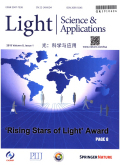- 钛学术文献服务平台 \
- 学术期刊 \
- 工业技术期刊 \
- 电工技术期刊 \
- 光:科学与应用(英文版)期刊 \
null
Red light at intensities above 10 Ix alters sleep-wake behavior in mice
基本信息来源于合作网站,原文需代理用户跳转至来源网站获取
摘要:
Sleep is regulated by two mechanisms:the homeostatic process and the circadian clock.Light affects sleep and alertness by entraining the circadian clock,and acutely inducing sleep/alertness,in a manner mediated by intrinsically photosensitive retinal ganglion cells.Because intrinsically photosensitive retinal ganglion cells are believed to be minimally sensitive to red light,which is widely used for illumination to reduce the photic disturbance to nocturnal animals during the dark phase.However,the appropriate intensity of the red light is unknown.In the present study,we recorded electroencephalograms and electromyograms of freely moving mice to investigate the effects of red light emitted by light-emitting diodes at different intensities and for different durations on the sleep-wake behavior of mice.White light was used as a control.Unexpectedly,red light exerted potent sleep-inducing effects and changed the sleep architecture in terms of the duration and number of sleep episodes,the stage transition,and the EEG power density when the intensity was >20 Ix.Subsequently,we lowered the light intensity and demonstrated that red light at or below 10 Ix did not affect sleep-wake behavior.White light markedly induced sleep and disrupted sleep architecture even at an intensity as low as 10Ix.Our findings highlight the importance of limiting the intensity of red light (≤10 Ix) to avoid optical influence in nocturnal behavioral experiments,particularly in the field of sleep and circadian research.

推荐文章
期刊_丙丁烷TDLAS测量系统的吸收峰自动检测
带间级联激光器
调谐半导体激光吸收光谱
雾剂检漏 中红外吸收峰 洛伦兹光谱线型
不同盐度、温度及光照对漂浮浒苔生理生态的影响
浒苔
盐度
温度
光照
生理生态
期刊_联合空间信息的改进低秩稀疏矩阵分解的高光谱异常目标检测
高光谱图像
异常目标检测 低秩稀疏矩阵分解 稀疏矩阵 残差矩阵
内容分析
关键词云
关键词热度
相关文献总数
(/次)
(/年)
文献信息
| 篇名 | Red light at intensities above 10 Ix alters sleep-wake behavior in mice | ||
| 来源期刊 | 光:科学与应用(英文版) | 学科 | |
| 关键词 | circadian light light-emitting diode masking | ||
| 年,卷(期) | 2017,(2) | 所属期刊栏目 | |
| 研究方向 | 页码范围 | 39-48 | |
| 页数 | 10页 | 分类号 | |
| 字数 | 语种 | 英文 | |
| DOI | 10.1038/lsa.2016.231 | ||
五维指标
引文网络
引文网络
二级参考文献 (0)
共引文献 (0)
参考文献 (36)
节点文献
引证文献 (0)
同被引文献 (0)
二级引证文献 (0)
1975(1)
- 参考文献(1)
- 二级参考文献(0)
1976(1)
- 参考文献(1)
- 二级参考文献(0)
1982(1)
- 参考文献(1)
- 二级参考文献(0)
1991(1)
- 参考文献(1)
- 二级参考文献(0)
1993(1)
- 参考文献(1)
- 二级参考文献(0)
1996(1)
- 参考文献(1)
- 二级参考文献(0)
2000(1)
- 参考文献(1)
- 二级参考文献(0)
2001(1)
- 参考文献(1)
- 二级参考文献(0)
2002(1)
- 参考文献(1)
- 二级参考文献(0)
2003(2)
- 参考文献(2)
- 二级参考文献(0)
2005(1)
- 参考文献(1)
- 二级参考文献(0)
2006(2)
- 参考文献(2)
- 二级参考文献(0)
2007(1)
- 参考文献(1)
- 二级参考文献(0)
2008(3)
- 参考文献(3)
- 二级参考文献(0)
2009(1)
- 参考文献(1)
- 二级参考文献(0)
2010(2)
- 参考文献(2)
- 二级参考文献(0)
2011(1)
- 参考文献(1)
- 二级参考文献(0)
2012(2)
- 参考文献(2)
- 二级参考文献(0)
2013(3)
- 参考文献(3)
- 二级参考文献(0)
2014(6)
- 参考文献(6)
- 二级参考文献(0)
2015(1)
- 参考文献(1)
- 二级参考文献(0)
2016(1)
- 参考文献(1)
- 二级参考文献(0)
2018(1)
- 参考文献(1)
- 二级参考文献(0)
2017(0)
- 参考文献(0)
- 二级参考文献(0)
- 引证文献(0)
- 二级引证文献(0)
研究主题发展历程
节点文献
circadian
light
light-emitting diode
masking
研究起点
研究来源
研究分支
研究去脉
引文网络交叉学科
相关学者/机构
期刊影响力
光:科学与应用(英文版)
主办单位:
中国科学院长春光学精密机械与物理研究所
出版周期:
双月刊
ISSN:
2095-5545
CN:
22-1404/O4
开本:
出版地:
吉林省长春市东南湖大路3888号
邮发代号:
创刊时间:
语种:
eng
出版文献量(篇)
762
总下载数(次)
0
总被引数(次)
112
期刊文献
相关文献
推荐文献

 免费查重
免费查重










